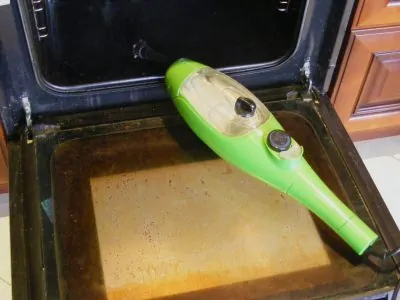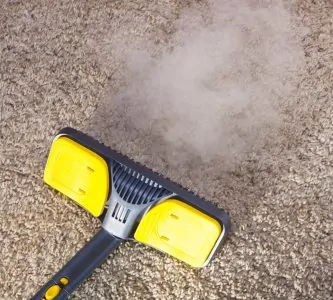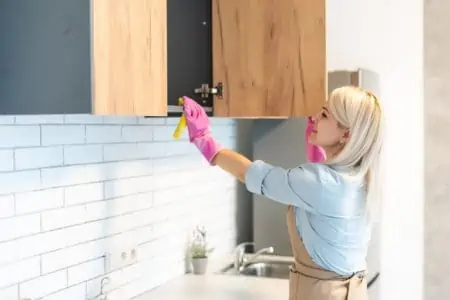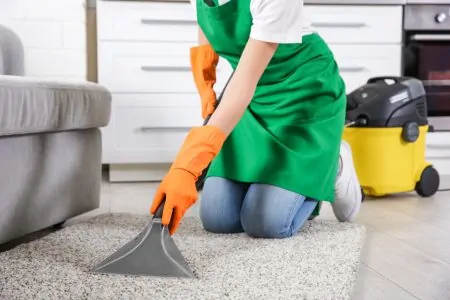We’ve all been confronted with the dreaded dirty oven. There’s a point where you can’t put it off any longer: the grime and gunk have to go.
For most of us, oven cleaning entails plenty of harsh chemicals and hard work. You hold your nose, get your gloves on and scrub until you can’t feel your arms any longer.
Our guide on how to steam clean ovens can offer you a simple alternative. Choose the method that best suits you and your oven best. Learn how to perform each one and stay safe in our comprehensive guide.
Key Takeaways
- Steam cleaning ovens is a non-toxic, low-effort alternative to using harsh chemicals for cleaning.
- Four methods for steam cleaning ovens include using self-clean steam, ammonia, vinegar, or a steam cleaner.
- For a safer cleaning process, follow manufacturer guidelines and take necessary precautions.
- To maintain a clean oven, use preventive measures such as placing aluminum foil on the bottom rack to catch spills.
Why Steam Clean Your Oven?
As you likely know, crusty oven mess doesn’t come off without a fight. That’s why typical oven cleaning agents are packed with harsh chemicals.
Popular brands such as Easy-Off come with a litany of warnings. Inhaling or touching the product can cause burns, only apply with rubber gloves, etc. (1).
Oven scouring pads containing lye were reported to have corrosive consequences (2). Toxicity from coming into contact with oven cleaners, in general, is well-documented (3).
In comparison, steam is nothing to play around with; it can result in scalds if mishandled. Little ones are particularly vulnerable to steam-related scalds (4).
Nonetheless, it’s a non-toxic, low-effort alternative to dangerous chemicals. If you decide to try our one chemical option (ammonia), you shouldn’t get overwhelmed.
How to Steam Clean Ovens
We understand that everyone is working with different preferences and equipment. So we offer four methods to work for all ovens and all people.
You don’t need a modern oven or specialized tools to benefit from steam. For those of you who have these things, we’ll tell you how to use them.
1. Using Self-Clean Steam
Take a quick peek at your oven. Do you see an option that reads “steam clean” anywhere on the control panel?
If so, your model is equipped to steam itself clean. Typically, there’s little intervention required on your behalf.
All you have to do is add water into your oven and set it to steam. The exact instructions and quantity of water will depend on your specific model. Consult the manufacturer guidelines and follow the included directions.
2. Steam Clean Oven With Ammonia
For plenty of people, ammonia is a go-to solution for cleaning jobs great and small. If you fall into this category, follow the steps below:
- Preheat oven: Set your oven to the lowest temperature and switch it on.
- Boil water: Bring water to a boil in your biggest oven-safe dish or pan.
- Insert large container: Once the oven is heated, put your oven-safe container (e.g., a casserole dish) on the bottom rack of your oven.
- Switch oven off: Turn your oven off; you don’t need the heat anymore.
- Add ammonia: Get another oven-safe container or bowl and set it on the top rack. Pour no more than one cup of ammonia into it. Re-insert the rack.
- Shut oven door and leave overnight: Close your oven door and leave the steamy ammonia to work overnight.
- Air oven out: The next morning, open the kitchen windows and let your oven air out for at least 15 minutes. The stench of ammonia will likely be pretty powerful. Quarantine the kitchen so that no one inhales ammonia fumes (5).
- Wipe away gunk: Put your gloves on. You should find that stubborn debris comes off easily. Mix the ammonia bowl into the water container and dunk your sponge into it for an added boost.
- Clean residue: Clean your oven with plain water on a sponge or rag until no traces of ammonia (odor or liquid) remain.
Warning
3. Steam Clean Oven With Vinegar
Are you the sort who prefers chemical-free cleaning? Then distilled white vinegar should do the trick. Vinegar is acidic, which makes it an ideal non-toxic cleaner (7).
- Heat up oven: Preheat your oven to 450 degrees Fahrenheit. If you have a self-clean steaming option, you’ll select that instead.
- Choose oven-safe container: Choose a large bowl, dish, or pan that isn’t too deep. You want the steam to billow throughout the oven. Set it on the top rack.
- Mix vinegar and water: Mix one part vinegar with one part water. If your oven is in rough shape, you can use pure vinegar instead.
- Pour solution in: Carefully fill the container with your vinegar solution. Don’t overdo it; if it’s full to the brim, removing it may be hard later.
- Wait and watch: Keeping your oven on, let the vinegar work its magic. Let it steam for no less than 20 minutes and no more than one hour. Monitor it periodically. If you see all the liquid in your container has evaporated, switch the oven off.
- Let oven cool and clean: Once the oven is cooled down, pop it open and wipe it down with a scrubby sponge. Use a plastic spatula tool for tougher grime. Don’t postpone doing this (e.g., waiting hours after it’s cool), or the debris won’t loosen as easily.
4. Using A Steam Cleaner
Steam cleaners are handy devices that can make quick work of tedious jobs. If you don’t have one at home, see if you can rent one.
- Remove racks: Take your racks out of the oven so that you can access the whole appliance with your steam cleaner.
- Prepare steam cleaner: Fill up the water tank and let the gadget heat up, as per the manufacturer’s instructions.
- Attach accessory of choice: If you have a scrub brush attachment, now is the time to use it. It can help with particularly neglected ovens.
- Start steaming: Run the steam slowly over your oven’s walls, ceiling, and floor. Wipe away the dirty water and melted gunk with a sponge, rag, or paper towel.
FAQs
Praise the Steam
Oven-cleaning duty no longer has to be a punishment with steam. We hope you’ve found a technique that appeals to you in our guide.
One Last Tip
One way to reduce how often you need to steam clean your oven is prevention. Place aluminum foil on your bottom rack to catch spills.
Be careful when putting food in and taking food out. Small precautions like this can keep the interior of your oven looking clean for longer.










